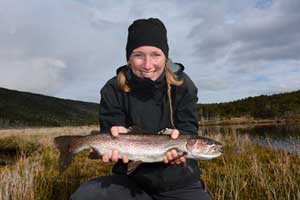Rainbow Trout Winter Fishing


Trout are the most widely distributed game fish in the world due partly to their tolerance of wide ranging water temperatures
Ice Fishing for Rainbow Trout
Unfortunately ice fishing doesn’t offer the same level of mobility as fishing from the shore or a boat. You can end up drilling a hole and find there are no fish close by. Many seasoned anglers will drill several holes separated by 15 feet or more with each hole fished at the same time.
The best approach is to drill holes about 10 feet apart over a depth gradient towards the deepest part of the lake. This of course doesn’t apply to the Great Lakes, some of which are much deeper.
Tips
- Drill an 8 inch hole. Gas powered augers are preferred over hand driller when the ice is over 2 feet thick
- Use a 6 to 8 pound monofilament line and size 6 or 8 hook.
- Ice will form repeatedly over the hole. Bring a small strainer to skim the ice from the hole
- Go light rubber or split shot sinker. Nothing too heavy, just enough to sink the line
Bait
Rainbow Trout are not fussy fish. They do have preferences and will stick to a given food for a few hours before changing preference.
These fish travel in schools and schools keep to the same bait preference for about an hour or two. When one fish in the school changes their preference, they all change. No-one is sure how they communicate this.
Shrimp are a popular food for Rainbow and Steelhead Trout. Even landlocked trout enjoy shrimp despite the fact that it’s not a natural bait. Over the years we’ve heard strange tips that farmed Rainbow Trout love frozen shrimp from the supermarket.
The simple fact is that you don’t have to work hard to find a bait that works.
- Shrimp work well as do maggots, earth worms, fathead minnows, sardines, smoked oysters, golden shiners and even those frozen shrimp for farmed salmon. Small marshmallows also work well as does fake crabmeat, (the kind found in food stores that’s often made of pollock).
Tips for finding the fish
- Lake bottoms where there’s sunken debris should be given top preference
- If 20 minutes passes without a bite, it’s time to move on. Don’t wait all day hoping your luck will change
- In small lakes that are stocked by government programs, watch out for aeration machines that force a fresh supply of air into the water. You’ll often find Rainbow Trout close by
Be careful as the ice is usually thinner around the aeration point. Don’t climb over any fences and heed warnings as falling through the ice can be fatal.
- Fish off the bottom no more than 12 inches for best results and don’t go less than 10 inches. If the area has weed cover or other underwater debris, place the bait 12 inches above the bottom.
Ice Fishing Safety
Before heading out on a frozen lake, check the thickness. This information can be obtained by checking with the local police, the town, bait shops and even the chamber of commerce.
Ice is considered unsafe if it’s less than 15 centimeters/6 inches thick.
Ice needs to be a minimum of 45 centimeters/18 inches thick to support the weight of a vehicle. While some sites claim it only takes 2 inches to support a man, you’d be taking your life in your hands.
Ice thickness is not consistent. Ice is thinner near the shore where there’s a point and along pressure ridges. Areas of high current flow also provide thin ice. For lakes that have aerators to oxygenate the water, keep your distance.
- Note: Aeration keeps the water around it from freezing and ice that is frozen is usually much thinner than the average.
Check with local authorities for ice conditions and don’t go out on the lake without a compass and knowing how to use it.


